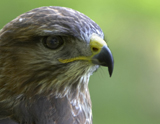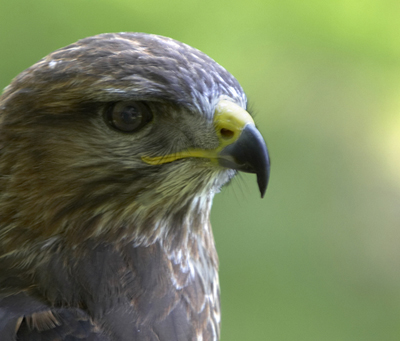Are buzzards now vermin?
Gamekeeper David Whitby and the RSPB’s Martin Harper debate whether we have to control the common buzzard population in the UK


The argument for
The common buzzard isn't an evil bird, says gamekeeper David Whitby, but there are now so many that the time has come to redress the balance of nature
'We have two sub-species of buzzard nesting on the estate in West Sussex where I work: the rare, and most welcome, summer-visiting honey buzzard and the increasingly less welcome common buzzard. The latter has a troubled history: it was the only bird excluded by Henry Vlll when he made egg-stealing illegal, James I of Scotland ordered its eradication and gamekeepers have always viewed it as a major predator. Buzzards are powerful birds of prey that have few, if any, enemies.
In the 1950s, myxomatosis and the effects of DDT caused them to be all but eliminated-numbers dropped to 10,000-15,000. Subsequently, they enjoyed a renaissance and are now the UK's most common bird of prey. Why? The secrets of survival for any living creature are protection from predators, suitable habitat and a sustainable food supply. The buzzard's once major predator is now itself an endangered species, having declined by 90% in the past 100 years. I am, of course, speaking of the gamekeeper.
In addition, buzzards have abundant suitable habitat and an incredibly diverse food supply. Although essentially hunters, they'll feed on carrion, plus rabbits, hares, all species of mice, shrews, voles, red and grey squirrels, crickets, grasshoppers, worms, slow worms, lizards, snakes and just about any bird they can catch. A colleague once saw a buzzard kill a barn owl and there's a YouTube film of a buzzard taking an osprey chick from the nest.
There's also a manmade influence that helps maintain the burgeoning population: the release of millions of young game birds at a time that coincides with the buzzards feeding their own young, which encourages better brood survival. The abundance of game-bird carcasses in the shooting season also sustains an unnaturally high overwintering population. How ironic that the buzzard's historical predator has inadvertently become a reason for its success. There's no doubt that the shooting industry is playing a substantial role in fuelling the buzzard boom.
My major concern, however, is the impact of the buzzard's higher survival rate on all wildlife, not just game birds. What do these powerful raptors eat when game is no longer on the menu? Whatever they can: lapwing chicks, red squirrels, grey partridge, dormice and other creatures whose populations simply can't withstand the augmented numbers of yet another predator.
Exquisite houses, the beauty of Nature, and how to get the most from your life, straight to your inbox.
The buzzard is a success story, but, for the sake of all our wildlife, its impact must be controlled. No native species should ever be persecuted to near eradication again, but it's vital that we control predators when their numbers are excessive. Correcting this imbalance has never been more important.'

The argument against
We should celebrate the buzzard's recovery as a conservation success story, says the RSPB's Martin Harper, and learn to live in harmony with birds of prey
'I often see buzzards on my way to work. Nothing unusual about that, you may think, but, two decades ago, I would've had no chance. Historically, buzzards were common, but Victorian persecution led to a population crash. Their recovery is a conservation success story: the result of strong legal protection and a genuine improvement in attitude by many gamekeepers. Buzzards only became part of my childhood when we moved from Kent to rural Herefordshire in the early 1980s.
But, today, children can see buzzards wherever they live. At a time when 60% of UK species for which we have data are declining, buzzards are a rare bright spot to celebrate. Buzzards are generalist predators, searching out the easiest sources of food. Often, this means scavenging carrion, but a high density of pheasants-particularly poults in a release pen-can make a tempting target.
Buzzards can also take species of conservation concern, such as lapwing chicks. However, there's no evidence that they're causing population-level declines of any native wildlife. In contrast, there is abundant evidence that other changes in the countryside, such as in farming practice, have caused dramatic population declines of native species.
Let's be honest, a good proportion of the people with an axe to grind over buzzards are concerned about the impact on pheasants. Pheasants, in contrast, are not a native bird. The Romans probably first started the trend that now sees nearly 40 million a year introduced for recreational shooting. On average, birds of prey kill 1%-2% of released pheasants. This is a tiny factor, especially when stacked up against the numbers killed on roads. Although losses to buzzards can be higher, these small figures can be reduced with the use of increased cover, visual deterrents and diversionary feeding.
The idea of killing buzzards to stop them taking pheasants is simply wrong. Killing a protected native bird of prey to increase a shootable surplus of a non-native gamebird is, in many ways, a return to Victorian intolerance. Pheasant shooting undoubtedly has a place in our countryside. Indeed, some shoots make a positive contribution to conserving native wildlife by working with the grain of nature. Fighting it, by scapegoating buzzards, is the antithesis of this philosophy. Buzzards are a wonderful part of our natural heritage.
Their recovery is something to celebrate. Our wildlife is in crisis. Other raptors, such as the hen harrier, remain in dire straits because of illegal killing. Allowing the licensed killing of buzzards is fundamentally damaging for everyone. It was legal protection that helped bring about its recovery. It's vital that we protect and enhance legal protection, rather than seeking to undermine it. Nations have signed up to the convention on biological diversity whose strapline is living in harmony with nature. A key test of whether we're living sustainably in 21stcentury Britain is whether we can coexist in harmony with predators such as birds of prey.'
* Follow Country Life on Twitter
Country Life is unlike any other magazine: the only glossy weekly on the newsstand and the only magazine that has been guest-edited by His Majesty The King not once, but twice. It is a celebration of modern rural life and all its diverse joys and pleasures — that was first published in Queen Victoria's Diamond Jubilee year. Our eclectic mixture of witty and informative content — from the most up-to-date property news and commentary and a coveted glimpse inside some of the UK's best houses and gardens, to gardening, the arts and interior design, written by experts in their field — still cannot be found in print or online, anywhere else.
